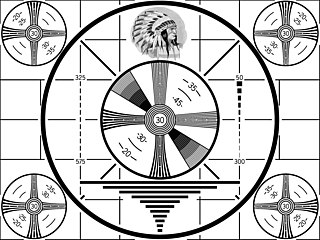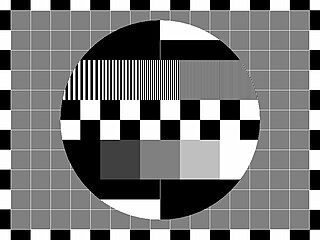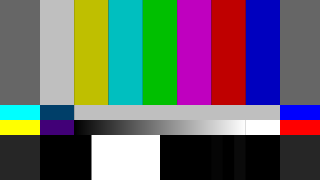 W
WA test card, also known as a test pattern or start-up/closedown test, is a television test signal, typically broadcast at times when the transmitter is active but no program is being broadcast. Used since the earliest TV broadcasts, test cards were originally physical cards at which a television camera was pointed, and such cards are still often used for calibration, alignment, and matching of cameras and camcorders. Test patterns used for calibrating or troubleshooting the downstream signal path are these days generated by test signal generators, which do not depend on the correct configuration of a camera, and can also test for additional parameters such as sync, frames per second, and frequency. Digitally generated cards allow vendors, viewers and television stations to adjust their equipment for optimal functionality. The audio broadcast while test cards are shown is typically a sine wave tone, radio or music. More recently, the use of test cards has also expanded beyond television to other digital displays such as large LED walls and video projectors.
 W
WETP-1 was a test card designed and used by the Independent Broadcasting Authority (IBA). After test transmissions from the IBA's Engineering Regional Operations Centre (ROC) in Croydon from 1978 it was phased in on ITV over a period starting from 1979, replacing - in different ITV areas - Test Card F, Test Card G and full screen height colour bars. After ITV went 24 hours in 1988, the card ceased to be seen on the channel.
 W
WThe Indian-head test pattern is a test card that was introduced in 1939 by RCA of Harrison, New Jersey, for calibration of the RCA TK-1 monoscope. It was widely used by television stations worldwide during the black-and-white television broadcasting era. It features a drawing of a Native American wearing a headdress along with numerous graphic elements that test different display aspects.
 W
WA monoscope was a special form of video camera tube which displayed a single still video image. The image was built into the tube, hence the name. The tube resembled a small cathode ray tube (CRT). Monoscopes were used beginning in the 1950s to generate TV test patterns and station logos. This type of test card generation system was technologically obsolete by the 1980s.
 W
WA multiburst waveform is a useful test pattern used to quickly ascertain the frequency response of a video system. The name derives from the multiple bursts of sine wave in the active video section of the waveform which are generated with (usually) increasing frequency, but identical in amplitude. The test pattern is usually input at the start of the signal chain and analysed at the end. By measuring the amplitude of each of the 'bursts' of waveform at the end of the video chain, spot measurements of the frequency response of the system can be obtained and errors in the response quickly identified.
 W
WThe Philips PM5540 is a test pattern generator that could be considered a black & white predecessor of the widely used Philips PM5544 test pattern. It has been used in Australia, Abu Dhabi, Denmark, Israel, Qatar and the Netherlands. A heavily modified version of the PM5540 test card was used by Sjónvarpið of Iceland from 1966 until 1982, and the latter test card was also used by some regional broadcasters of the German public broadcasting corporation ARD as well as by the national German public broadcaster ZDF.
 W
WThe Philips PM5544 is a television pattern generator, most commonly used to provide a television station with a complex test card commonly referred to as a Philips Pattern or PTV Circle pattern. The content and layout of the pattern was designed by engineer Finn Hendil in the Philips TV laboratory in Copenhagen under supervision of chief engineer Erik Helmer Nielsen in 1966–67. The equipment, the PM5544 Test Pattern Generator, which generates the pattern, was made by engineer Finn Hendil and his group in 1968–69. Since the introduction of the PM5544 in the early 1970s, the Philips Pattern has become one of the most commonly used test cards, with only the SMPTE bars, the BBC Test Card F and the Snell & Wilcox Zone Plate coming close to its usage.
 W
WSMPTE color bars are a trademarked television test pattern used where the NTSC video standard is utilized, including countries in North America. The Society of Motion Picture and Television Engineers (SMPTE) refers to the pattern as Engineering Guideline (EG) 1-1990. Its components are a known standard. Comparing it as received to the known standard gives video engineers an indication of how an NTSC video signal has been altered by recording or transmission and what adjustments must be made to bring it back to specification. It is also used for setting a television monitor or receiver to reproduce NTSC chrominance and luminance information correctly.